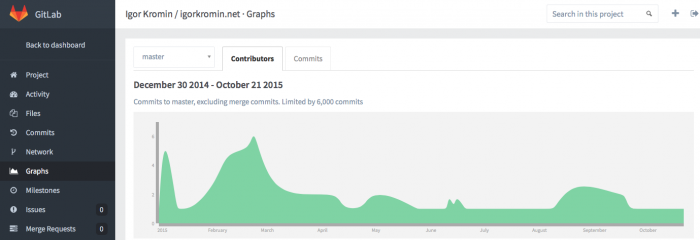I had a SVN repository on my server at home that used a non-standard layout. It didn't have a trunk directory nor did it have branches or tags. The 'trunk' was the repository root itself. After a bit of hacking around I finally converted this repository to Git with all the history intact.
So lets see what I did. In a nutshell what I wanted to do was move the SVN repo over to GitLab. I only cared about the trunk and didn't want the branches or tags to be present in the Git repository (since they didn't exist anyway). In terms of actual URLs, it looked like this:
SVN to Git
SVN Source: svn://[email protected]:8080/igorkrominnet
Git Target: [email protected]:ikromin/igorkromin.net.git
First thing was to create an author mapping file. Since I knew that I was the only contributor this was easy and I could just create it by hand. The format is svn_user = git_author. It should look something like this, one line per mapping (I only have 1 mapping).
authors-transform.txt
ikromin = Igor Kromin <[email protected]>
Now was the fun part, the actual migration of SVN data to Git. I did this in a temporary directory, which I'd recommend because you can just wipe it out in case something goes wrong and you have to start all over.
Migration commands
cd ~/Downloads
mkdir temp
cd temp
git svn clone svn://[email protected]:8080/igorkrominnet --no-metadata -A authors-transform.txt --trunk=. svngit
To explain this, first I change directories to the Downloads folder and create a temp directory and change to that. The 'git svn clone' command is where all the real action is. Here I specify the source SVN repository by its URL. Since this is a one-time migration, I also specify --no-metadata. The author mapping is provided next via the -A flag. The --trunk=. option basically equates to 'use the repository root as the trunk', since I am not using a standard layout this is a critical option to specify. The svngit parameter is just the name of the directory to clone the SVN repo into.
This can take some time, depending on the size of the SVN repository and amount of commits there were to it.
Once the clone was done I wanted to migrate all of the ignore data. However running the following command gave me an error...
SVN GIT Ignore Error
> git svn show-ignore
config --get svn-remote.svn.fetch :refs/remotes/git-svn$: command returned error: 1
When I looked inside the .git/config file, the fetch was incorrectly set, so I updated it to be 'igorkrominnet:refs/remotes/git-svn' in my case.
diff .git/config .git/config.bak
...
fetch = igorkrominnet:refs/remotes/git-svn
...
After this I was able to extract the ignore data with the following commands...
SVN GIT Ignore Data
git svn show-ignore > .gitignore
git add .gitignore
git commit -m 'Convert svn:ignore properties to .gitignore.'
At this point the SVN repository was migrated to Git, but it was still locally on my machine and not in GitLab. To get it to GitLab all I had to do was set a remote origin and push the changes. I already had an empty Git repository created in GitLab prior to this step.
Git push to remote
git remote add origin [email protected]:ikromin/igorkromin.net.git
git push -u origin master
That was it! At this point I could delete the temp directory I created and clone the Git repository in the location I actually wanted to use it.
All the history was magically there...
-i

